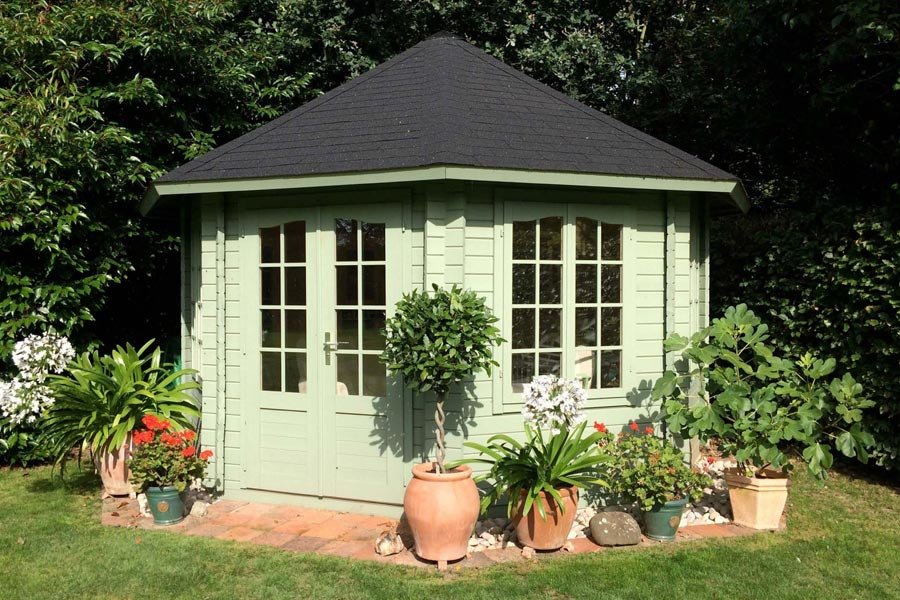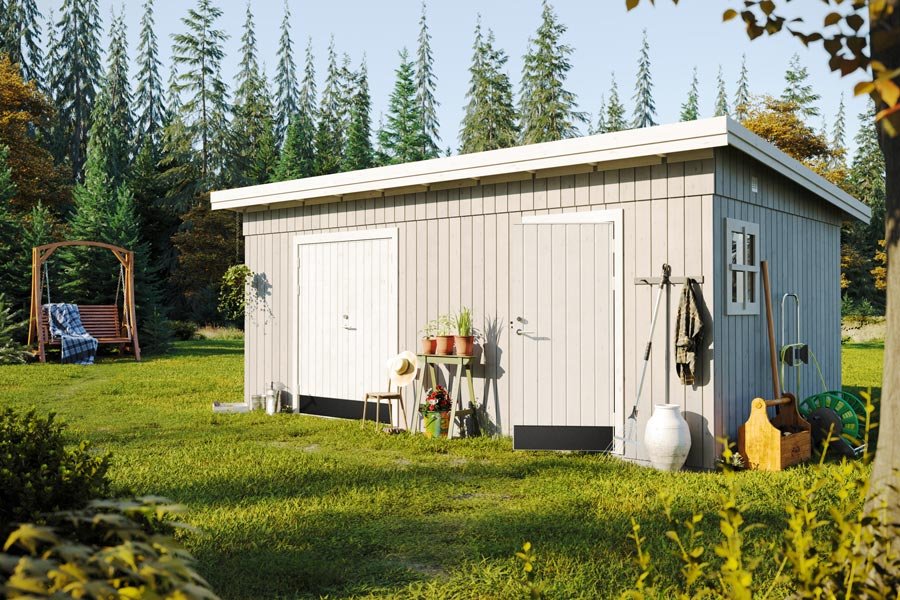
by Mark Bailey | Nov 2, 2016 | GardenLife Magazine, How to guide

For novice or semi-committed gardeners, planting bulbs can be the ideal form of gardening. You do some gentle digging, plant the bulbs, ignore them for a few months, and then wake up in spring to a bank of daffodils, tulips, alliums or other bulbs of your choice. If only all gardening could be like this.
In addition, bulbs come in a vast range of varieties, colours and sizes, and it’s worth exploring beyond the obvious ones like daffodils, crocuses, snowdrops and tulips. Bulbs also offer great flexibility in terms of where and when you plant them.
When to plant bulbs
A rough rule of thumb is that you plant spring-flowering bulbs in autumn, and autumn-flowering bulbs in spring. The best time to plant spring crocuses, snowdrops and daffodils is generally September and October, however, November is the ideal time to plant tulips, which like to be planted when the soil is colder (plant them earlier, and they are vulnerable to a fungal disease called tulip fire).
If you really want a new crop of daffodils next year, and have left the planting late, some guides to bulb-planting say you may be able to get away with doing it in November, especially if you live in the warmer parts of the UK.
Where to plant bulbs
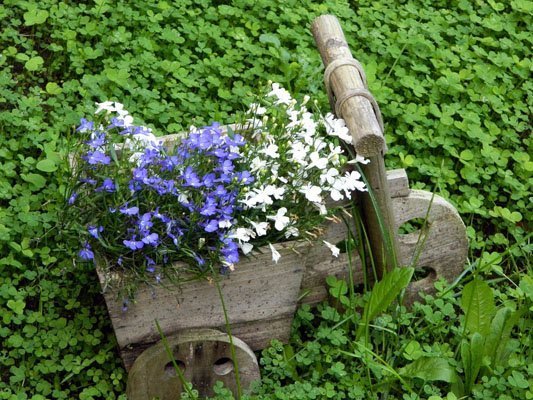
Popular bulbs such as daffodils and tulips can be grown in a variety of places and for a variety of purposes:
- To fills gaps in borders.
- Around the outside of a summer house.
- In formal (or random) displays in flowerbeds, which can then be succeeded by displays of annuals later in the summer. Conventional wisdom is that the larger showier tulips look better planted in formal arrangements, but this is a matter of opinion.
- Around the base of a tree – this looks more natural with smaller bulbs such as snowdrops, crocuses, dwarf daffodils, and winter aconites
- En masse on a grassy bank – think Wordsworthian daffodils.
- In containers, either using a single variety or a mixture. The Crocus website has good ideas for container planting, including how to make a ‘bulb lasagne’ of tulips, hyacinths and crocuses, planting them in layers so that they flower throughout spring.
How to plant bulbs
The cardinal rule with bulbs is to plant them the right way up! This will generally mean with the sharper end pointing upwards.
The usual advice is to plant them at three times the depth of the bulb, and two widths apart. The RHS has a nice video about planting bulbs, and you can use the following guide to help work out the best planting depth for your chosen bulb.

If you want more encyclopedic information about the what, where and when of planting bulbs, and what to do after they’ve flowered, you can’t go wrong with RHS advice.
What conditions do bulbs prefer?
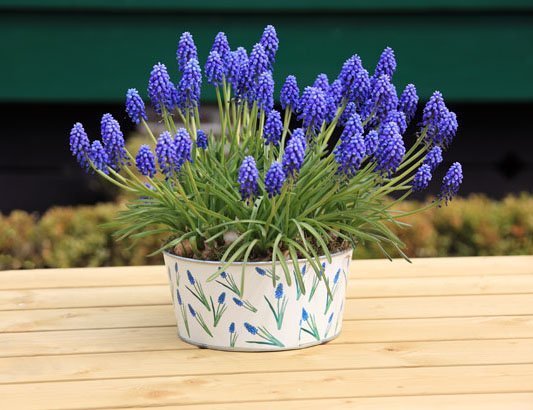
The general answer is that bulbs like sun (full or partial) and good drainage. However, there are also bulbs that will grow well in shade.
If you are growing bulb in containers, you will generally need to plant them in a pot with a drainage hole at the bottom, which you can cover with broken pottery to prevent the drainage becoming excessive.
How to protect bulbs from pests
The biggest threat to your bulbs could well be squirrels, which dig them up and perhaps eat them (depending on the type of plant). In a more rural area badgers may well dig up everything that you plant, leaving your lawn or beds full of empty holes. The bulbs are particularly vulnerable when newly-planted since the soil is likely to be loose. Covering the soil with chicken wire, and leaving it there until the first shoots appear should protect them.
Inspirational ideas for planting bulbs

There are wonderful spring bulb displays all over the UK, from the snowdrop CCC at Cambo to the Tulip Festival at Pashley Manor Gardens, on the Sussex-Kent border, in April-May each year, with a display of around 100 varieties. Gardeners at the Eden Project, in Cornwall, planted around 30,000 bulbs in the winter of 2015 (although this might not be feasible in your average back garden)!
Even if you don’t plan to compete with Pashley and the Eden Project, you may get some good ideas for formal or informal bulb settings, either from visiting in person or looking at pictures.
Bulb sourcing
If you want the basics, your local supermarket or DIY will probably have multipacks of bulbs, with clear instructions. If you’re buying bulbs in person, look for firm bulbs, and avoid any that are soft, shriveled or have signs of mould.
If your bulb plans are more ambitious, there are various specialists with online shops. Large generalist garden websites such as Crocus.co.uk also have good selections. Specialists include:
- Glendoick has a wide choice of bulbs, and, being Scottish, some good advice about growing bulbs in colder northern climates.
- Peter Nyssen has a vast supply of different bulbs, and has some suggestions about popular bulbs for beginners or even children. The website is limited in terms of planting advice, but it has a nice tool for browsing and planting by colour.
- Bloms Bulbs also has a vast choice, and some good practical advice on growing tulips, daffodils and other bulbs.
Planting bulbs in spring
If you really feel you’ve left the bulb planting too late this autumn, your next option will be to get out into the garden in early spring, and plant some bulbs for next autumn. There’s a useful list of ideas for autumn/winter 2017 on the Thompson & Morgan site.

by Mark Bailey | Oct 18, 2016 | GardenLife Magazine, How to guide

New and traditional ways to preserve fruit and veg
Autumn is synonymous with harvest time, and if you have more than a couple of fruit trees, current bushes or a decent-sized vegetable patch, you’ll be vastly exceeding your five portions a day throughout September and October. When you grow your own fruit and veg you want to make the most of harvest time, but you may well have enough produce to last into the following year.
You’ll therefore need to find ways to store some of your garden produce to make it last. The ingredients for doing this will range from pickling spices to a garden shed, and techniques can involve simple crates, jam jars and even the odd new gadget too. Of the new and traditional ways to preserve fruit and veg the following five main options will help you deal with your surplus fruit and veg.
The best way to store fruit and veg
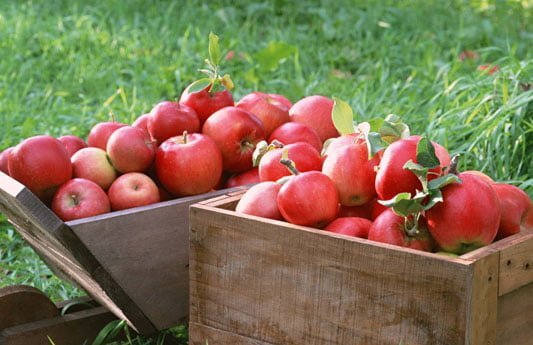
Before you start worrying about pickles and freezers, remember that some fruits and vegetables can be stored in your garden for several weeks – as long as you handle them right.
Top of the list for storing in your garden building – as long as it is dry and ventilated – is apples. It’s possible to buy traditional apple racks, but as they can be just a little pricey any carefully lined crates or shelves will do. Handle all fruit delicately to avoid bruising, and store it in a single layer without fruits touching each other. Make sure they are clean and dry too.
Pears can also be stored in your garden shed, though will need regular checks, as they can easily and quickly over-ripen.
Other good fruit and vegetables for storage include potatoes, carrots, beetroot, and of course onions and garlic. Many root vegetables, such as parsnips, swede and celeriac, are especially easy to store because they can simply be left in the ground until you need them.
There are good general tips for storing fruit and vegetables online and Grow Your Own magazine also has regular seasonal advice on storing garden produce. The mighty RHS website also has excellent detailed advice on storing fruit as well as separate advice about storing vegetables.
Try drying your own fruit and veg

Rather than storing your vegetables in a dry place, but how about going one step further and deliberately dry or even dehydrating the fruits of your garden labours?
Drying’s not going to work for everything – root veg, for instance, and we’re not convinced about the attractions of dried apple (it’s flavoursome, but a bit like chewing on rubber). However, if you grow herbs, chillies or beans, drying them is simple and practical.
The old-fashioned way is to suspend them on thread in a warm airing cupboard, which is practical for herbs and chillies. The modern version is to use a dehydrator, and this opens up the scope for dehydrating your own berries, cherries and currents too. If, however, you don’t want food dangling from cupboards or the expense of a new gadget, you can also dry chillies, slices of fruit and bunches of herbs by leaving them on a low heat (around 100°) in the oven all day.
Freezing food from your own garden

Captain Birdseye may be extremely proud that his peas go from field to freezer within a few hours but you can easily beat that at home. And if you have the space in your freezer to store the contents of your garden, you can keep produce in great shape for months. Freezing also keeps high levels of vitamin C in fruit and veg.
There are different requirements for freezing different fruits and vegetables – a few, such as raspberries, can be frozen as they are; but most need to be blanched (briefly immersed them in boiling water) before freezing; and others will only freeze well if cooked.
And if you have a glut of cucumber, kale, lettuce or radishes, you’re probably better off looking at other methods of preserving them, or eating them immediately.
There are some good starter tips at for freezing home-grown produce online.
Preserving fruit and veg for all year use

Stories of people having chutney recipes handed down from their great-grandmother can be offputting, because it suggests there are secret skills involved in making jams, jellies, chutneys and pickles.
Not at all. It’s surprisingly quick and easy. Shops such as Lakeland are an easy source for the kit you’ll need, from jars to old-fashioned gingham lid covers. Preserving your own produce is also ideal for more delicate vegetables and soft fruit, berries and currents that can’t be left in the shed or dried in an airing cupboard.
The tips below will also be useful if you’re a preserves novice:
- Don’t make too much. There’s nothing more dispiriting than finding you still have 5 unopened jars of last year’s plum chutney when the next plum season has already arrived.
- Only use good fruit and vegetables. For all the talk about windfall chutney, you’re better to use unblemished produce if you want preserves to stay edible and safe.
- Follow instructions about sterilising jars, lids etc.
- A jam thermometer is invaluable for telling if your jam is cooked – much easier than old-fashioned solutions involving multiple chilled saucers and water.
Great sources of recipes include Perfect Preserves by Thane Prince – apparently dubbed the ‘queen of preserves’ by The Times newspaper – are available on the Waitrose website.
Different ways to preserve your fruit and veg
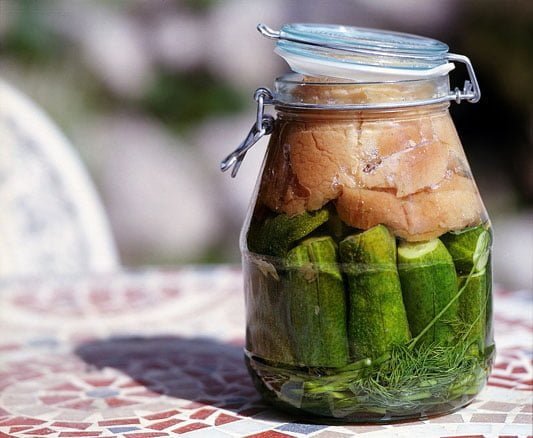
If you want to try an alternative to cold storing, drying, dehydrating, freezing and preserving your home grown fruit and veg, there are other options out there. If you want to get a bit more adventurous try the following:
- Quick pickle vegetables – slice and submerge vegetables in an acidic liquid such as vinegar, lemon juice, pomegranate juice, soy sauce or miso. It’s faster and less hassle than making a chutney, plus the taste will be completely different too.
- Ferment your own wine or vinegar – If you are really overburdened with a bumper crop of fruit or sweet vegetables you could make your own homemade wine or custom vinegar.
- Dry salt vegetables – packing freshly picked vegetables in dry salt not only preserves them, but it can intensify the flavour and improve the texture. Check out some simple techniques.
- Macerate fruits with alcohol – it couldn’t be easier. Too many berries, cherries or currents? Wash and dry them then drown them in your favourite alcoholic tipple. Vodka, rum and brandy work particularly well (the alcohol should be 80% proof) and you can also add dried spices and sugar to intensify sweetness.
- Smoking food – typically fish and meat is smoked to preserve it. Smoking vegetables doesn’t have the same effect, but if you’re going to the trouble of making a chutney or salt curing veg, you could consider smoking it first to add a different distinctive flavour.
With all these new and traditional ways to preserve fruit and veg, you should be able to make the most of your autumn harvest throughout the whole year.

by Mark Bailey | Sep 26, 2016 | GardenLife Magazine, How to guide

Some of the UK had 30+ degree temperatures this September, so you might think a post about garden shed maintenance advice is badly timed, but the first Christmas puddings also arrived on supermarket shelves this month. This, and the ever shortening days, is always a depressing signal that autumn is really upon us.
Whilst it may be fine to leave the Christmas food and present shopping until late December, protecting your garden shed from autumn and winter gales won’t wait that long.
The rain, wind and damp of a British autumn are the three great enemies of any timber garden building. If you want to get maximum enjoyment and longevity from a garden shed, summer house or garden office, you need to keep them at bay. Here’s our garden shed maintenance advice broken into 10 handy tips that you should consider this autumn.
Tip number 1: Ensure nothing is left touching the building
Cut back any trees and shrubs near your timber garden buildings, as they will prevent air flow, and make it harder for timber to dry out between rain showers. Even worse, overhanging branches can easily damage the roof felt or shingles in high winds. It might be tempting to leave garden furniture, tools or logs resting against the back wall of the building where they are out of sight, but you need to leave a clear gap to stop moisture building up.
Tip number 2: Use the best garden shed timber treatment and preserver

All exposed wood should be treated with good quality wood preservative to prepare it for winter. Ideally, you will have done this when you first installed the building, but you also need to reapply regularly. GardenLife recommend Barrettine wood preserver to stop wood boring insects, rot and fungal infection, plus Barrettine log cabin oil to help form a watertight layer. Cuprinol also has a good range of wood preservatives and protectors, as well as some good advice on how to protect and revive a shed.
And if you want to makeover your garden shed more radically, there are excellent stains and paints for timber buildings available in the Sadolin and Sikkens ranges.
If chemical infused preservatives or solvent based treatments aren’t for you, we also covered some environmentally friendly options for wood stain in an earlier blog post.
Tip number 3: Check the roof of your shed

If you have loose shingles, felt or flashing, their chances of surviving high winds are dicey. Far better to make small repairs before the first gales of winter strike than to have to deal with far bigger emergency roof repairs and water damage post-storms. You can buy replacement felt and shingles at most large DIY chains, and if you want to re-roof a GardenLife building get in touch with us and we can quote for the appropriate amount of felt or shingles.
Tip number 4: Get out the oil can
Check that hinges, handles, locks and padlocks are moving freely, and give them a coat of oil to keep it that way. If you need to get oil inside locks or handles get a spray can of WD-40 with a straw – you can then spray right inside moving parts without having to take things apart. Also check that doors or windows open and shut easily; if they don’t, you’ll need to investigate further to check that frames haven’t swollen, warped or twisted. If you need to sand or plane a surface down to free a sticking door or window, remember to reapply wood preserver and treatment afterwards.
Tip number 5: Clear all gutters

If your shed or garden building has gutters, check they’re not blocked. Clear away all leaves and other blockages, and keep on doing this throughout the autumn. If gutters block, water may overflow down timber walls, causing damp problems. Should your garden building be located underneath a large tree, leaf build-up could be a persistent problem. In this instance you might want to consider adding a mesh leaf trap guard to the top of your downpipe. This will allow water to flow through, but will stop leaf litter blocking the downpipe.
If your building doesn’t have gutters, look out for problems with water building up on roofs or running down the walls. It may be that adding gutters could prevent the problem escalating into more serious water damage. If you don’t like the look of gutters you could consider rain chains as much more interesting solution instead.
Tip number 6: Get rid of some junk
Freeing up some space in your summerhouse or workshop won’t in itself prolong its life. But a good tidy-up and clear-out may help you spot damp, watermarks, mould, nests or other problems.
In particular, have a rigorous inspection of the interior next time it rains, searching for any new leaks or damp problems that need treatment.
Tip number 7: Look out for the windows
Internal timber window frames and sills can sometimes develop damp problems caused by condensation, especially outside the summer months. Applying a quick coat of clear wood treatment to internal sills and frames can head off these problems. If the sills or frames are already damp, you’ll need to dry them out first.
Tip number 8: Clean surrounding decking and paving

Throughout the autumn, clear away leaves from your decking, including from any gaps. They can cause discolouration and perhaps damp too. When damp and covered in algae decking and paving can be like an ice rink. A good clean with a fungicidal decking cleaner and reviver will help remove algae, moss and mould from decking and paving. You may also need to reapply decking stain or treatment once the timber has dried. There’s some good advice on the B&Q website.
Tip number 9: Check out your shed base
Grass and leaves around the foot of a timber building can reduce air flow around and under the building, and prevent wooden walls or foundation joists from fully drying out. This makes the building more vulnerable to problems with damp, even where you have pressure-treated timber.
Tip number 10: Hunt down your spirit level and try square
While you’re on a maintenance session, you may also want to ensure that walls, door frames and windows are still at 90 degrees to the ground. If not, you may be suffering problems with subsidence or damp. Your heart will sink at having to work out how to solve the problem, but better to do so now than when further damage has set in!
If you follow this garden shed maintenance advice early each autumn you should ensure that your shed or garden room remains in good condition and continues to provide you with many years of trouble free use (but if you do need a new one, we can always help!).

by Mark Bailey | Sep 9, 2016 | GardenLife Magazine, How to guide

When it comes to beautiful garden design most people fail to consider the importance of the garden path. A path can just be a simple route from A to B, but it can also be the backbone of your garden design. A path can transform the appearance of your garden and how it’s used. Either way, a creative garden path could hugely improve your garden.
The practical benefits of a garden path
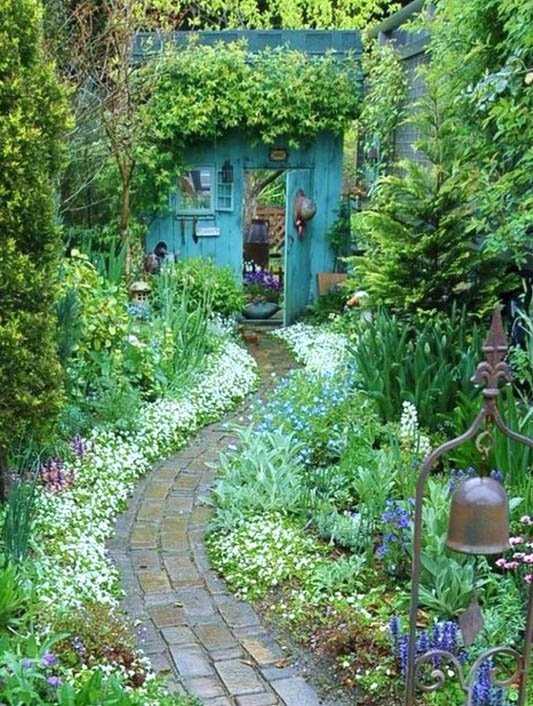
Take the same route from your backdoor to your garden office, compost bin, shed or garage a couple of times daily, and in a rainy year, your lawn could look like a mud bath. In a bad November you may need wellies just to reach the garage.
The best way to rescue your lawn is to build a path. Not only will you avoid the trench effect, but you could make your garden look longer, wider and more interesting.
Unusual garden path ideas: create an optical illusion

There are lots of clever tricks of the trade when designing a creative garden path. For example:
- a path starting at 45 degrees from the house, and curving sinuously can make a garden look bigger and wider
- a tapering path that narrows at the end of the garden can make the whole garden look longer
- a path can steer the eye towards the garden’s best features, from an attractive garden building to a beautiful shrub. It can also create greater cohesion between your home and different garden buildings, or act as a divide, creating a route through different planting zones
- solar powered lights can highlight a path at night, or even change its colour
The best material for a garden path?
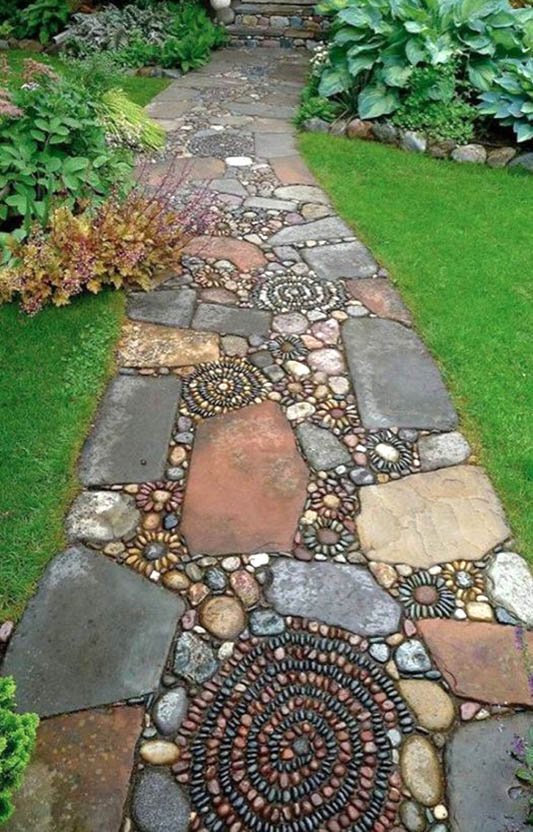
The crunch of a gravel path is always satisfying; other benefits of gravel include:
- it drains really well
- it’s good value for money
- it’s easy to lay
- it has a low environmental impact
- it can improve security (it’s very difficult to walk on a gravel path around a house without making noise)
And though gravel paths are not the most exciting option around, visual interest can be increased by breaking up the gravel with groupings of natural stone or granite slabs. Or you could try planting ground cover perennials, such as alchemillla (ladies’ mantle) in the gravel.
If you’re looking for other garden path ideas there are lots to choose from. Cheap materials for pathways include wood bark, pebbles, wood chips or stone chips, the last of these available in a wide range of colours.
If using coloured stone chips, remember that the colour will intensify when they are wet, so choose your shade with that in mind. You should also consider the impact of the stone colour on neighbouring plants too. Neutral colours can help blend a path into its surroundings, whereas a contrasting colour such as white granite or grey/blue slate will make the path stand out. Whatever you decide, if you use gravel, bark, wood or stone chips it’s best to put a layer of weed proof membrane underneath to minimise future maintenance.
There are a vast range of other possible materials for an interesting garden path; from traditional York stone (either new or salvaged), to recycled bricks, modern concrete, wooden sleepers or even raised decking. Decking can also add height to your walkway, which adds extra interest.
Each material has its pros and cons, in terms of price, durability, drainage, ease of use, and general appearance. You can get a good idea of what’s available in your budget range on the Jewson website.
Garden path edging ideas

Edging a path will prevent gravel or chips from migrating into the surrounding grass, and also make it look smarter. Possible edging materials include timber (which should be treated pleasure-treated with preservative), terracotta or slate tiles, or modern steel edging.
Again the choice will come down to price and taste. If you’re not sure, then visit as many gardens as possible to see what other people have used. Alternatively, look at websites such as Pinterest – there are some great examples of some really creative garden path ideas.
The best width for a garden path?

The best width for your path will partly depend on the size of your garden. Also entering your decision-making should be:
- narrower paths tend to encourage people to walk faster; broader paths offer more of an invitation to stroll
- generally, garden designers recommend a path is wide enough for two people to walk side by side, but a practical A-to-B path to a bin or shed can be narrower
- think about practicalities – whether you need enough width for a wheelchair or lawnmower, and if you should leave a gap in the edging to allow easy access for a wheelie bin or wheelbarrow
A straight garden path v. a curving garden path

The shape of the path depends on your taste and the space available. A meandering or curved garden path will generally make your garden look more interesting or bigger, but may not be practical if your family are likely to head for the bike shed or workshop by the shortest possible route.
Curved paths are also relatively easy to make yourself if you intend to use materials such as gravel or woodchip. However, you may need a professional garden landscaper to lay a curved garden path made of paving slabs or timber decking.
Straight paths are more likely to be used in larger, formal gardens, and may do little to enhance the design of a smaller garden. But if you want to add visual interest to an existing straight path, the options include:
- a pergola or arches to walk under
- a fountain, water feature or pond with a bridge to walk over
- interrupting the straight line by adding a paved area or bench part way along the path
- alternating between two different materials, such as mix of slabs and woodchip, or “stepping stones” slabs surrounded by gravel of a contrasting colour
The House and Home website has some inspirational and highly creative garden path ideas.
How to lay a garden path
There’s not the space here for a full tutorial on building a garden path, but there is plenty of good advice online. This video by Monty Don on the Gardeners World website covers all the basics.
There’s excellent guidance on building gravel, concrete or block paving paths on the Wickes website, and this also tells you all the materials you’ll need. From a spirit level to check that the base is level, to weed-resistant landscaping material for the base, to the right type of mortar.
If you follow these seven creative garden path ideas you could end up improving the look of your garden as well as making it feel bigger. You’ll also be rid of the quagmire that comes with winter weather too.

by Mark Bailey | Aug 17, 2016 | GardenLife Magazine, How to guide

With many of our customers, we find that buying a summer house or garden room is part of a wider garden design overhaul. And the ideal complement for a new garden building is often a pond – perhaps in another part of the garden, or possibly built into a decking area or on a patio by the summer house.
After all, if you’re planning to spend more time in your garden, a pond can make your garden view more interesting and varied. And it can attract a huge variety of wildlife – from hedgehogs to dragonflies to frogs and newts, which as well as giving you something to look at, can also help to control slugs and snails.
A fountain or waterfall, either connected to the mains or a solar panel, can also add another dimension to your pond. Sitting on the decking outside your summer house can be very relaxing; add the calming sound of running water to the mix and you’ll be in heaven.
Making a garden pond is no longer the DIY project from hell

Go back a few years (or decades) and building a garden pond could be the DIY project from hell. I’m sure some of you have a few childhood memories of the bad old days of trying to build concrete or clay-lined ponds in the back garden.
Fast forward to today, and these projects are far easier, with a huge choice of liners, both molded and flexible. Possible materials include fibre glass, PVC, butyl and EPDM; they all ensure that making a garden pond is a lot easier than it used to be.
The affordability and range of mini-diggers also allows for a large pond to be dug in even an average sized back garden (or one with ground too difficult to excavate by hand). A summer house with decking overhanging a large landscaped pond is no longer the complex and expensive task it once was.
Choosing the best garden pond liner

The advantage of molded or preformed pond liners is that they don’t puncture or tear, but they don’t allow you much flexibility in the design (typically rounded triangles, rectangles or squares with two different depths). In contrast, PVC, butyl and EPDM liners are cheaper, and used much more frequently, but are more susceptible to leaks (a good layer of sand, or even carpet underlay, is recommended under such pond linings).
There’s also a material called Bentomat, which is ‘self-mending’ and made from natural materials. It’s easy to install and is often used for large-scale constructions such as canals or fisheries, but can also be used at home to make a small garden pond.
If you’re not sure which pond liner to go for there’s a good summary on the Telegraph Lifestyle site, and a very interesting blog post on LochNessWaterGardens.com about ponds and water gardens, covering subjects from liners to koi to pond predators.
The best location to make a garden pond?
As well as researching pond liners, you’ll need to think about where you position your pond. You’ll probably want to have it somewhere you can see it – either from your house, or from your new summer house. Partial shade is recommended, since too much sunlight can encourage algae growth. But water plants will also need sun for part of the day, so avoid all-day shade.
Having trees overhanging the pond is not ideal, as you’ll have to spend time removing dead from the leaves. Tree roots could also end up puncturing your lining.
It’s a good idea to avoid building the pond in a spot that is boggy or marshy. You wouldn’t think this would matter, but having a high water table underneath the pond can cause damage to the liner when the water level rises.
There are good tips to get you started on a simple rectangular liner pond with a decking surround on the Gardeners World website. If you want more nuanced ideas on shape, position and designing a pond, take a look at World of Water.
On a much simpler scale, the Royal Horticultural Society website has some good ideas for container water gardens, using old baths or wooden barrels.
Sunken ponds versus raised ponds

One solution for areas where digging isn’t possible, or the water table too is high, is to have a raised (or partially raised) pond. You won’t get rising water (or roots) damaging your liner, and raised ponds can often be safer for children and animals than sunken ponds.
A further benefit of raised ponds is that, with less digging and excavations to do, they can be easier to build (for instance, making a garden pond out of timber is a lot less backbreaking than excavating heavy clay soil). They can stand on pretty much any sturdy surface, as long as it is stable and can bear the weight of the water, such as concrete, paving, earth or decking.
There are various options for constructing a raised pond, including stone or concrete sides (such as you would see in a formal garden) or a timber frame.
Attracting wildlife to your garden pond

Finally, if you plan to watch your own garden wildlife show from your new summer house, you’ll need a wildlife-friendly pond. For example, it’s vital to think about how small animals or amphibians will get in and out of it. Clearly, raised ponds are less mammal-friendly; and so are ponds with steep sides, where animals will struggle to get out.
Instead, you’ll need gently sloping sides, and perhaps a beach or ramp made out of stones or pebbles. You’ll also need a range of plants that are wildlife-attracting and can help oxygenate the water (particularly if you want to keep fish, and like clear rather than murky water). If you get the right mix of plants you can attract frogs, toads, newts and dragonflies, and other creatures such as birds and hedgehogs may well use the pond to drink.

Once constructed and planted, your garden pond will soon improve the look of your garden. It will give nature a helping hand, offer a beautiful view from overlooking windows or the summer house, and when combined with a fountain or some subtle underwater lighting, a relaxing addition to the patio, border or decking.

by Mark Bailey | Mar 14, 2016 | GardenLife Magazine, How to guide
Gardens can look desolate in March, despite the valiant efforts of spring sunshine and blooming snowdrops, daffodils and crocuses. Lawns can look ragged, pale and full of moss, flower and vegetable beds bare, and the ravages of winter storms are on full display. Even so, March is also an exciting time for anyone with a garden. The days are longer, there’s some warmth in the sun, and it’s time to get started on creating a beautiful (but practical) living and entertaining space for the summer. Here are some top tips for spring gardening jobs.
1. Hold back on the seeds
With shops full of seeds, the temptation is to get planting immediately. But don’t start sowing too early in March. We’re still likely to have some frosts, especially in Scotland and northern England, and you should wait for the ground to warm up. But there are plenty of projects to start instead, and you can also start planting some veg in the greenhouse or indoors.

2. Go on pest patrol
Take action against slugs, which could ravage new spring shoots, especially hostas. Whatever your preferred methods – physical, organic or chemical – for protecting your garden against slugs, it’s time to deploy them. Onto more spring gardening jobs.
3. Your lawn needs you
Early spring is the time to get the lawnmower out of storage. If you have a few rain-free days, and the grass is dry, do a gentle mowing session, with the lawnmower on its highest setting. If the lawn is particularly long you might want to consider cutting it one day on a high setting, then the next day going over it again on a slightly lower setting (trying to cut a long damp lawn on a low setting could stress the lawn mower and wear you out too). The RHS website has lots of advice on cutting lawns in early spring.
4. Be nourishing
Top dress containers with new compost, ready for the growing season, and consider adding some plant food or bonemeal to help and sustain healthy growth. You can also tidy borders, and mulch them with compost or manure. If you have a wood burning stove you can add your wood ash to beds and the carbon will help invigorate the earth. The soil has a hard summer ahead, and needs all the nutrients it can get.
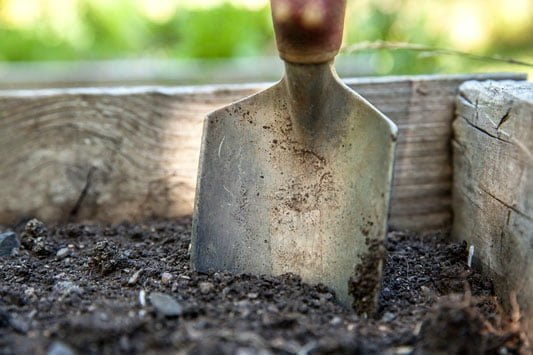
5. Deal with weeds
It’s useful to tackle weeds early in the year before they get out of hand. It’s also easier to spot them if beds and borders are relatively empty, and remember to check cracks in patios and paths for weeds too.
6. Get busy in the greenhouse
Before your greenhouse gets too cluttered with seedlings, or festooned with summer tomatoes, take a good hard look around you, and notice the dust, cobwebs and dirt. It’s a dirty job, but one of these essential spring gardening jobs.
Cleaning and disinfecting benches, floor, windows and even pots and seed trays will help get rid of any diseases or bugs that have wintered in your greenhouse. Jeyes Fluid is widely recommended, or garden centres may recommend other products. Make sure everything dries and ventilates thoroughly before you start planting seedlings and cuttings.
7. Get the really boring jobs over for the year
Repair post-winter fences and trellises; clean and sharpen gardening tools; and tidy the garden shed so that you can reach the lawnmower without falling over two spades and a sunshade. Maybe make a shopping list of all those things that you regularly need throughout the year, such as buying some extra compost (if you don’t make you’re own), plant food, new tree stakes and ties, and pest control pellets. Much better to do these jobs now and have supplies read when you need them.

8. Make plans for your garden
Although the site of snowdrops and late frosts make it too early for some planting, it’s not too early to plan. Get looking at catalogues, websites and the like, and try something new. Check out our garden design ideas and inspirational photos on Pinterest. If you leave this until June or July, you’ll just be kicking yourself that all your amazing new discoveries needed to be planted out in April.
9. Think big
The emptiness of a March garden makes this the best time to dream up a project. Look around you with a fresh but harsh eye. Do you really like those shrubs in the corner? Has that beloved forsythia actually grown far too tall? Has the buddleia taken over a favourite corner? Would the end of your garden become much usable if you installed a summerhouse? Wouldn’t it be wonderful to work in a garden office this summer?
10. More advice on spring gardening jobs
Without further delay, get browsing, whether it’s a seed catalogue; a social media site with ideas for patios; or a collection of garden buildings or summer houses. Your plans may turn the Easter break into a gruelling 72-hour DIY or gardening marathon, but they will set you up for a wonderful garden summer.
For other good ideas on spring gardening jobs, there’s some great advice at:
The weekend newspapers (or their archives) are also a good source of seasonal gardening advice and spring gardening jobs. A word of caution though – national newspapers may well be geared towards readers in southern England. If you live in a colder, northern area, you may want to delay their advice by a fortnight or so.








































